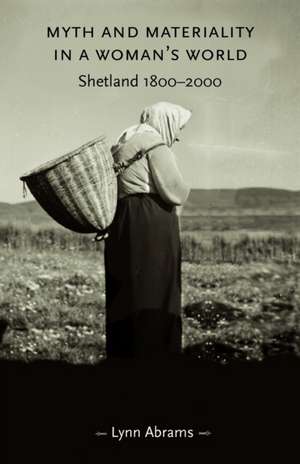Myth and Materiality in a Woman's World: Gender in History
Autor Lynn Abramsen Limba Engleză Paperback – iun 2010
| Toate formatele și edițiile | Preț | Express |
|---|---|---|
| Paperback (1) | 224.60 lei 6-8 săpt. | |
| MANCHESTER UNIVERSITY PRESS – iun 2010 | 224.60 lei 6-8 săpt. | |
| Hardback (1) | 720.56 lei 6-8 săpt. | |
| MANCHESTER UNIVERSITY PRESS – 10 noi 2005 | 720.56 lei 6-8 săpt. |
Din seria Gender in History
-
 Preț: 247.47 lei
Preț: 247.47 lei -
 Preț: 108.05 lei
Preț: 108.05 lei -
 Preț: 154.92 lei
Preț: 154.92 lei -
 Preț: 206.85 lei
Preț: 206.85 lei -
 Preț: 154.92 lei
Preț: 154.92 lei -
 Preț: 154.92 lei
Preț: 154.92 lei -
 Preț: 204.49 lei
Preț: 204.49 lei - 23%
 Preț: 537.66 lei
Preț: 537.66 lei -
 Preț: 246.55 lei
Preț: 246.55 lei - 5%
 Preț: 662.58 lei
Preț: 662.58 lei -
 Preț: 223.44 lei
Preț: 223.44 lei -
 Preț: 205.86 lei
Preț: 205.86 lei -
 Preț: 280.06 lei
Preț: 280.06 lei - 23%
 Preț: 536.30 lei
Preț: 536.30 lei -
 Preț: 108.39 lei
Preț: 108.39 lei - 23%
 Preț: 537.06 lei
Preț: 537.06 lei -
 Preț: 207.71 lei
Preț: 207.71 lei -
 Preț: 231.86 lei
Preț: 231.86 lei -
 Preț: 224.60 lei
Preț: 224.60 lei -
 Preț: 282.58 lei
Preț: 282.58 lei -
 Preț: 224.60 lei
Preț: 224.60 lei - 23%
 Preț: 721.29 lei
Preț: 721.29 lei -
 Preț: 222.08 lei
Preț: 222.08 lei -
 Preț: 235.43 lei
Preț: 235.43 lei -
 Preț: 223.61 lei
Preț: 223.61 lei -
 Preț: 221.70 lei
Preț: 221.70 lei -
 Preț: 281.42 lei
Preț: 281.42 lei -
 Preț: 342.00 lei
Preț: 342.00 lei - 23%
 Preț: 722.17 lei
Preț: 722.17 lei - 23%
 Preț: 740.85 lei
Preț: 740.85 lei - 23%
 Preț: 743.22 lei
Preț: 743.22 lei - 23%
 Preț: 719.65 lei
Preț: 719.65 lei - 23%
 Preț: 720.56 lei
Preț: 720.56 lei -
 Preț: 281.20 lei
Preț: 281.20 lei -
 Preț: 278.70 lei
Preț: 278.70 lei -
 Preț: 221.49 lei
Preț: 221.49 lei -
 Preț: 278.70 lei
Preț: 278.70 lei - 23%
 Preț: 737.06 lei
Preț: 737.06 lei - 23%
 Preț: 720.56 lei
Preț: 720.56 lei -
 Preț: 224.97 lei
Preț: 224.97 lei -
 Preț: 223.99 lei
Preț: 223.99 lei - 23%
 Preț: 748.99 lei
Preț: 748.99 lei
Preț: 224.60 lei
Nou
Puncte Express: 337
Preț estimativ în valută:
42.98€ • 44.82$ • 35.72£
42.98€ • 44.82$ • 35.72£
Carte tipărită la comandă
Livrare economică 21 martie-04 aprilie
Preluare comenzi: 021 569.72.76
Specificații
ISBN-13: 9780719065934
ISBN-10: 0719065933
Pagini: 264
Dimensiuni: 140 x 216 x 15 mm
Greutate: 0.35 kg
Editura: MANCHESTER UNIVERSITY PRESS
Seria Gender in History
Locul publicării:United Kingdom
ISBN-10: 0719065933
Pagini: 264
Dimensiuni: 140 x 216 x 15 mm
Greutate: 0.35 kg
Editura: MANCHESTER UNIVERSITY PRESS
Seria Gender in History
Locul publicării:United Kingdom
Descriere
This book examines how in the nineteenth century Shetland became a female place. It offers fascinating insights into the formation and workings of a matriarchal society. The book includes a glossary and will appeal to those interested in local dialects, as well as students and academics of Gender Studies and Scottish History.
